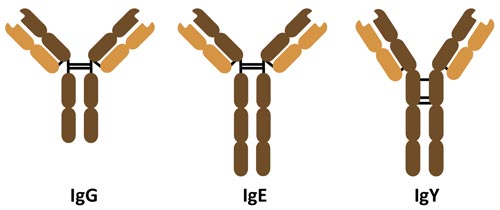What is IgY
Immunoglobulin Y (IgY) was first identified in eggs of immunized hens in 1893. Felix Klemperer showed that antibodies are not only present in the serum but also in the chicken egg yolk. However, these molecules were mistaken for IgG until more than 50 years later they were finally classified as an individual Immunoglobuline-class..
Characteristics
Chicken antibodies (IgY) have a comparable function to mammalian-IgG, but resemble IgE in structure (as shown). IgY-Immunoglobulins have two antigen-binding sites and the characteristic Y-shape, composed of two light and two heavy chains. With an additional constant domain in its heavy chain, the molecular weight of IgY (~180 kDa) is higher than of IgG, in addition IgY-antibodies lack a well-defined hinge-Region. Earlier studies suggested that the CH2 domain in the heavy chain of avian-antibodies may be the evolutionary precursor to the hinge-Region of mammalian-IgG.
Advantages
IgY can be produced in high quantity without harming animal health. A single hen lays up to seven eggs per week, 50-100mg of IgY-antibodies can be isolated from each egg. Since Chicken do not belong to Mammals, they can produce antibodies against highly conserved mammalian proteins, which do not cause an immunoreaction in rabbits. IgY have further advantages relative to IgG due to the phylogenetic divergence. IgY-Immunoglobulins do not bind to mammalian Fc-Receptors or bacterial Fc-binding proteins such as Protein A (Staphylococcus aureus), Protein G (Streptococcus sp.) or Protein L (Peptostreptococcus magnus). Thus, reducing the risk of unspecific background staining and false-positive results as can occur in flow cytometry (FACS) with IgG. IgY does not react with human rheumatic factors (RF), that can be found in serum of patients with rheumatic arthritis and to a less extend (3-5%), in healthy individuals as well. IgY-antibodies neither activate complement cascade in mammalia nor bind human anti-mouse antibodies (HAMA).
Topseller
With our partner Nordic MUbio we are now able to offer antibodies by Gallus Immunotech. Gallus has have been the first manufacturer who specializes in the production of Immunoglobulins from chicken eggs. Selection of Topseller:
- Anti-c-myc Epitop-Tag (all,rec) from Chicken – unconj.
- Anti-c-myc Epitop-Tag (all,rec) from Chicken – Biotin
- Anti-Neurotoxin Type A (Heavy Chain Binding Domain) (Ba) from Chicken – unconj.
- More Primary Antibodies from chicken eggs
Literatur
- Klemperer, F. Ueber natürliche Immunität und ihre Verwerthung für die Immunisirungstherapie. Archiv f. experiment. Pathol. u. Pharmakol 31, 356–382 (1893).
- Leslie, G. A. & Clem, L. W. PHYLOGENY OF IMMUNOGLOBULIN STRUCTURE AND FUNCTION. J Exp Med 130, 1337–1352 (1969).
- Putnam, F. W., Takahashi, N., Tetaert, D., Debuire, B. & Lin, L. C. Amino acid sequence of the first constant region domain and the hinge region of the delta heavy chain of human IgD. PNAS 78, 6168–6172 (1981).
- Larsson, A., Bålöw, R. M., Lindahl, T. L. & Forsberg, P. O. Chicken antibodies: taking advantage of evolution–a review. Poult. Sci. 72, 1807–1812 (1993).
- Warr, G. W., Magor, K. E. & Higgins, D. A. IgY: clues to the origins of modern antibodies. Immunology Today 16, 392–398 (1995).
- Carlander, D. Avian IgY antibody : In vitro and in vivo. Acta Universitatis Upsaliensis. Comprehensive Summaries of Uppsala Dissertations from the Faculty of Medicine 1119. 53 pp. (2002).
- Niederstadt, L. & Schade, R. Was sind und was können polyklonale aviäre Antikörper. BIOspektrum 18, 174-177 (2012)
- Munhoz, L. S. et al. Avian IgY antibodies: characteristics and applications in immunodiagnostic. Ciência Rural 44, 153–160 (2014).

